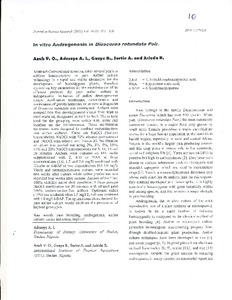| dc.contributor.author | Adesoye, A.I. |
| dc.contributor.author | Azuh, V.O. |
| dc.contributor.author | Gueye, B. |
| dc.contributor.author | Sartie, A.M. |
| dc.contributor.author | Asiedu, Robert |
| dc.date.accessioned | 2019-12-04T11:11:11Z |
| dc.date.available | 2019-12-04T11:11:11Z |
| dc.date.issued | 2011 |
| dc.identifier.citation | Adesoye, A.I., Azuh, V.O., Gueye, B., Sartie, A. & Asiedu, R. (2011). In vitro androgenesis in Dioscorea rotundata poir. Journal of Science Research, 10(3), 371-378 |
| dc.identifier.issn | 1117-9333 |
| dc.identifier.uri | https://hdl.handle.net/20.500.12478/2372 |
| dc.description.abstract | Conventional breeding takes several years to achieve homozygosity in yam. Anther culture technology is a rapid and viable alternative for the development of homozygous plants, therefore optimizing key parameters for the establishment of an efficient protocol for yam anther culture is indispensable. Influence of anther developmental stages, sterilization treatments, concentration and combination of growth hormones on in vitro androgenesis of Dioscorea rotundata was investigated. Anthers were grouped into five developmental stages from least to most matured, designated as Sml to Sm5. The criteria used for the grouping were anther size, color and location on the inflorescence. Three sterilization treatments were designed to produce contamination-free anther cultures. These are NaOCI (sodiumhypochlorite), NaOCI with 70% ethanol pretreatment and NaOCI with ethanol and Tween 20. Sterilization of spikes was carried out using 2%, 3%, 5%,10%, 15% and 20% NaOCI concentrations for 5, 10, 15 and 20 minutes. Anthers were cultured on MS media supplemented with 2, 4-D or NAA at three concentrations (1.0, 1.5 and 2.0 mg/l) combined with Kinetin or 6-BAP at two concentrations (0.5 1.0 mg/l). Viable and contamination-free anthers were recorded two weeks after culture while callus production was recorded four weeks after culture. Anthers of Sm2 had100% viabitity under dark condition. Fifteen percent NaOCI sterilization for 20 minutes with ethanol gave 100% contamination-free anthers. Optimum callus (15%) was produced when 1.5 mg/I 2, 4-D was combined with 1.0 mg/I 6-BAP. The optimal conditions derived for yam anther culture would facilitate the production of haploid genotypes. |
| dc.format.extent | 371-378 |
| dc.language.iso | en |
| dc.subject | Yams |
| dc.subject | Breeding |
| dc.subject | Androgenesis |
| dc.subject | Anther Culture |
| dc.subject | Callus |
| dc.subject | Haploidy |
| dc.title | In vitro androgenesis in Dioscorea rotundata Poir |
| dc.type | Journal Article |
| dc.description.version | Peer Review |
| cg.contributor.affiliation | University of lbadan |
| cg.contributor.affiliation | International Institute of Tropical Agriculture |
| cg.coverage.region | Africa |
| cg.coverage.region | West And Central Africa |
| cg.coverage.country | Nigeria |
| cg.authorship.types | CGIAR and developing country institute |
| cg.iitasubject | Yam |
| cg.journal | Journal of Science Research |
| cg.howpublished | Formally Published |
| cg.accessibilitystatus | Limited Access |
| local.dspaceid | 92281 |
| cg.targetaudience | Scientists |

